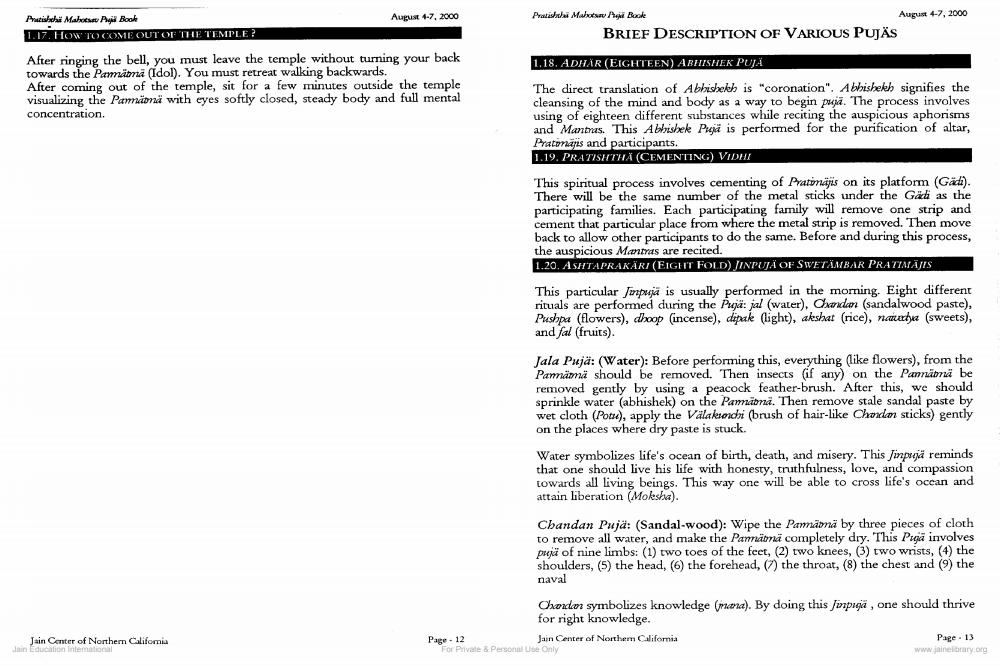Book Title: Puja Book Author(s): Publisher: USA Jain Center Northern Calfornia View full book textPage 6
________________ August 4-7, 2000 Pritchi Mahe Agil Book LIZ. HOW TO COME OUT OF THE TEMPLE? Pratishchi Mahew Mail Buck August 17, 2000 BRIEF DESCRIPTION OF VARIOUS PUJÄS 1.18. ADHÅR (EIGHTEEN) ABHISHEK PUJÄ After ringing the bell, you must leave the temple without turning your back towards the Pamäma (Idol). You must retreat walking backwards. After coming out of the temple, sit for a few minutes outside the temple ualizing the Pamion with eyes softly closed, steady body and full mental concentration. The direct translation of Abhishekh is "coronation". Abhishekh signifies the cleansing of the mind and body as a way to begin puja. The process involves using of eighteen different substances while reciting the auspicious aphorisms and Mantras. This Abhishek Piga is performed for the purification of altar, Pratinājis and participants. 1.19. PRATISHTHA (CEMENTING) VIDHI This spiritual process involves cementing of Patinajis on its platform (Gadi). There will be the same number of the metal sticks under the Gädd as the participating families. Each participating family will remove one strip and cement that particular place from where the metal strip is removed. Then move back to allow other participants to do the same. Before and during this process, the auspicious Mantas are recited. 1.20. ASHTAPRAKÄRI (EIGHT FOLD INPUJA OF SWETANBAR PRATIALAIS This particular puja is usually performed in the morning. Eight different rituals are performed during the Puja: jal (water), Cordon (sandalwood paste), Pushp (flowers), dhoop (incense), dipake (light), akshat (rice), nauuhu (sweets), and fal (fruits) Jala Pujä: (Water): Before performing this, everything (like flowers), from the Pamämä should be removed. Then insects (if any) on the Pannämä be removed gently by using a peacock feather-brush. After this, we should sprinkle water (abhishek) on the Pambra. Then remove stale sandal paste by wet cloth (Powe), apply the Valakesedhi (brush of hair-like Chalon sticks) gently on the places where dry paste is stuck Water symbolizes life's ocean of birth, death, and misery. This finpusia reminds that one should live his life with honesty, truthfulness, love, and compassion towards all living beings. This way one will be able to cross life's ocean and attain liberation (Molesha). Chandan Puja: (Sandal-wood): Wipe the Pamiona by three pieces of cloth to remove all water, and make the Pamänä сompletely dry. This Pegä involves puix of nine limbs: (1) two toes of the feet, (2) two knees, (3) two wrists, (4) the shoulders, (5) the head, (6) the forehead, 7) the throat, (8) the chest and (9) the naval Credo symbolizes knowledge (mana). By doing this song, one should thrive for right knowledge. Jain Center of Northern California Page - 13 Personal use only Jain Center of Nonhem California Page - 12 For PiPage Navigation
1 ... 4 5 6 7 8 9 10 11
